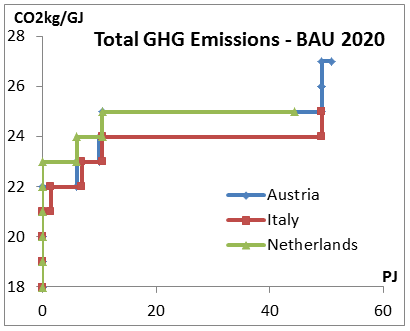The figure presents the total GHG emissions of palm pellets for all BAU 2020. As explained in the report, although the range of GHG emissions is fixed due to application of EU default values for the four scenarios, there are more palm pellets to be mobilised at the same GHG in the future timelines as well as in High Export scenarios.
GHG emissions of palm pellets reaching Italy indicate lowest values whilst to the Netherlands showing highest number. This can be explained by the location of Italy as the nearest destination from the Indonesian harbours whilst the Netherlands is the most remote country.
In addition to the calculation of GHG emissions, the estimation of GHG savings of using palm pellets as bioenergy carriers compared to FT-diesel use has been investigated. It is interesting to note that using palm pellets could save a significant amount of GHG emissions, in average it saves 82% in consideration with FT-diesel for transport fuel and 88% when being compared to electricity generation from FT-diesel. More details are provided in Table 5-1. These numbers also indicate that GHG emissions reduction requirements in a number of EU countries would be met (a requirement of 60% GHG emissions reduction in the UK, 70% GHG emissions reduction in Denmark and the Netherlands).

